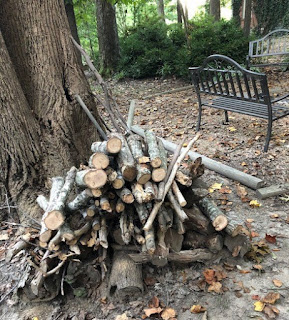Of all the parks that I am exploring, this is the one that nobody needs directions to. If you live in West Tennessee, you have driven through it hundreds or thousands of times. It is the stretch on Interstate 40 between Jackson and the Tennessee River where the farmland gives way to thick pine forests. Just take exit 116, and go south. The ranger station is less than five minutes away.
For all the stomping around this state I have done, it is embarrassing to say, but I have only been there a couple of times in my life. So in trying to come up with a new place for close to home adventures, it is hard to ignore that giant green blob on the map just to the east. We finally got a sunny Saturday a few weeks ago, so Brody and I headed that way. Here are a few observations....
1) The place is gi-normous. Besides the typical State Park campgrounds and cabins, there is an equestrian center, a shooting range, and an archery range. There are 4 lakes, including the 690 acre Pin Oak Lake, some with boat rental facilities. There are 50 miles of hiking trails which include a 40 mile loop with over night back country sites. There are 50 miles of multi use trails for mountain bike, ATV, or horseback riding (these are essentially old fire roads), and there are 250 miles of dedicated horseback riding trails in the south end of the park.
While a 5 or 6 hour visit to most State Parks will allow you to cover the vast majority of what there is to see, you could go at least a dozen times to Natchez Trace and not cover the same ground twice.
2) The visitors are spread out too. The size of the place allows for easy access to solitude. Even if there are a lot of visitors, there is no real central area for people to congregate. Our visit was late in the morning on a Saturday with about the most ideal weather we ever get here, and for the most part we didn't encounter anyone until late in the afternoon. Yes, there were some birthday parties and we did see a Boy Scout troop toward the last parts of the trail, but compared to other parks I have visited, the crowds were thin. There were plenty of good spots on the bank of Cub Lake to fish, and I didn't see a single boat. The picnic area where I parked, had no cars in the morning, and one other car in the afternoon.
 |
| There may have been two other people fishing on the whole lake. |
3) It can be a little navigationally challenging. So the free map that you pick up from the ranger station, is a little hard to read, mostly because there are so many trails and roads that it is hard to pack it all into an 8.5 x 11 sheet of paper. The muti-use trails all have signs, but there are a lot of them and you really have to be careful not fly past them on the main road. There are parking areas everywhere and they are really hard to spot on the map. When Brody and I set out on our adventure, I could only vaguely discern where the Cub Lake Trail actually began and ended. We parked in a random looking picnic area, crossed the bridge across the lake, and worked our way west through the complex of cabins to eventually find the trail head. There was a sign stating that it was 5.9 miles long and that you needed to carry half a gallon of water per person and plan on 3 to 4 hours to complete it. That seemed a little over the top to me. It was a little before noon. We had two bottles of water and some chocolate chip cookies. I knew we would have lunch a little late but otherwise we would breeze through it. My main concern was that I really could not tell where the trail actually ended, but that worry was a good six miles away.
The trail followed the lake shore, first south and then back north. Views of the water were plentiful and there was even a really nice back country shelter on the far eastern shore. Toward the end, there were some pretty extreme swampy parts that involved some technical stump jumps, but we emerged onto a road around 2:30. Of course I really had no idea where we were.
So Brody got his first experience with my personal favorite game in outdoor pursuits. I call it, "Find the Truck". This was an easy round of it. My favorite episodes of "Find the Truck" usually involve a winter night in on a secluded road in the Smokies. This time we just followed the road for a bit until I recognized the turnoff we had taken that morning, and the truck emerged!
So if you haven't been to Natchez Trace in a while, you should definitely give it a visit. Just remember to give yourself a little extra time for getting lost. But in reality, a little navigational uncertainty only helps with the feeling of discovery and adventure. And I have never lost a vehicle yet!
 |
| The sign was for a birthday party but it was really appropriate. |
So if you haven't been to Natchez Trace in a while, you should definitely give it a visit. Just remember to give yourself a little extra time for getting lost. But in reality, a little navigational uncertainty only helps with the feeling of discovery and adventure. And I have never lost a vehicle yet!






















